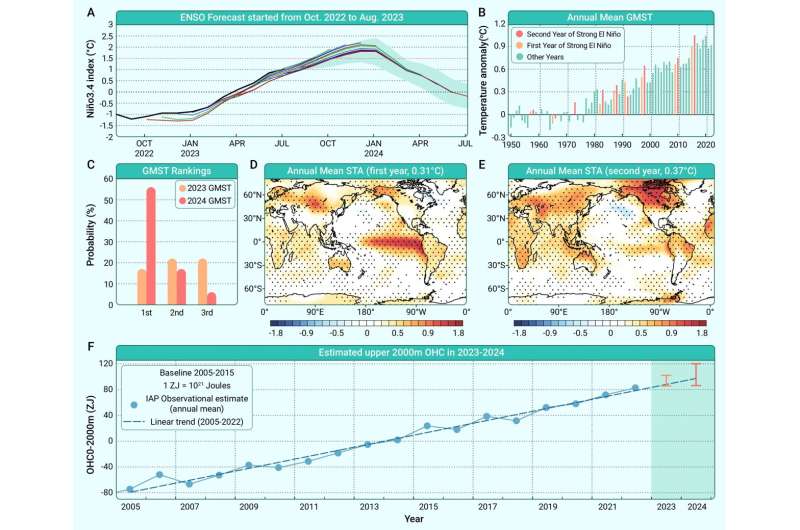This article has been reviewed according to Science X's editorial process and policies. Editors have highlighted the following attributes while ensuring the content's credibility:
fact-checked
trusted source
proofread
Strong El Niño expected to drive record-breaking global surface temperatures and trigger climate crises in 2023–2024

A strong El Niño event is going to wreak havoc on global surface temperature and trigger several climate crises in 2023–2024, according to researchers from the Institute of Atmospheric Physics (IAP) of the Chinese Academy of Sciences.
The El Niño event, known for releasing massive heat into the atmosphere, is poised to change atmospheric circulation patterns, influence tropical-extratropical interactions, and impact subtropical jets, monsoons, and even polar vortices, and finally results in a rapid surge in Global Mean Surface Temperature (GMST).
The study was published in The Innovation Geoscience on Sept. 15.
GMST, which integrates global land surface temperature and sea surface temperature, is one of the vital indicators of climate variability and global warming. Its interannual variability is primarily dominated by ENSO events, with El Niño events being particularly influential due to their capacity to release immense heat into the atmosphere, leading to anomalies in atmospheric circulation and changes in the surface energy balance.
Earlier in 2023, the ensemble prediction system developed by IAP has predicted that there will be an El Niño event in boreal autumn and may be maintained throughout winter.
Based on historical climate data and prior studies, the IAP team revealed the potential extent and consequences of the extreme warming expected in 2023–2024. Their findings indicate a 17% probability that the 2023 GMST will become the highest recorded since 1950, and a staggering 61% probability that it will rank among the top three. In 2024, these probabilities suddenly rise to 56% and 79%, respectively.
During the development of a strong El Niño in 2023, warm anomalies are expected to predominantly affect the tropical central-eastern Pacific, the Eurasian continent, and Alaska. However, in the following year, 2024, warm anomalies are likely to encompass the entire continents, significantly increasing the chance of land-based heat waves, droughts, and wildfires.
According to Prof. Zheng Fei, corresponding author of the study, "In addition to the surge in surface temperatures, the strong El Niño in 2023-2024 is predicted to trigger a cascade of climate crises." These include marine heat wave intensification, ocean deoxygenation, oceanic diversity reduction, damages of marine ecosystems, sea level rise, and crop yields reduction.
Furthermore, China may face multiple climate anomalies during this period. For instance, the suppressed winter monsoon in 2023 may lead to elevated winter temperatures in most regions of China and could also increase the probability of air pollution. In 2024, northern China may experience drought in spring, while southern regions are most likely need to face the risk of extreme rainfall and flooding during the summer.
More information: Kexin Li et al, Record-breaking global temperature and crises with strong El Niño in 2023–2024, The Innovation Geoscience (2023). DOI: 10.59717/j.xinn-geo.2023.100030
Provided by Chinese Academy of Sciences




















